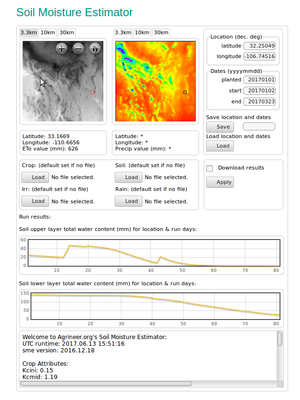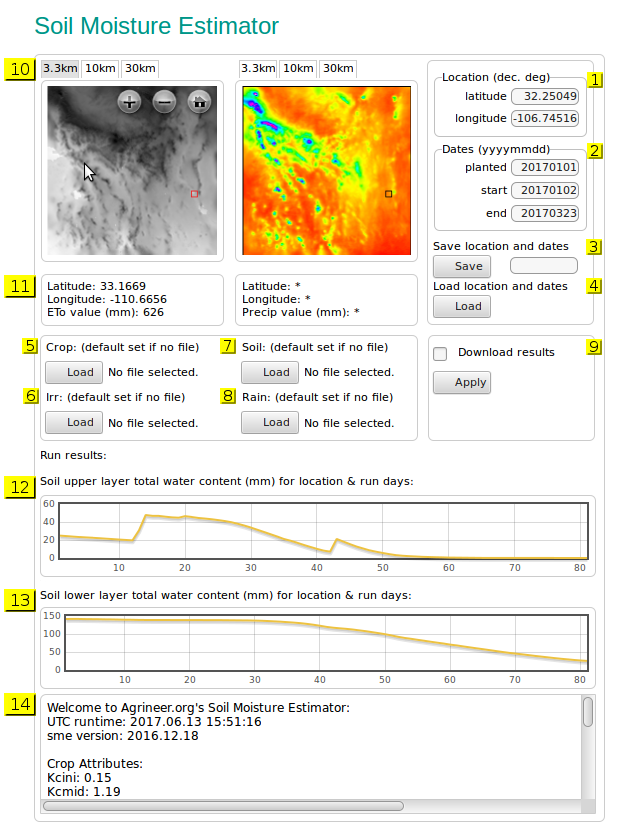Soil Moisture Estimator
Description, Disclaimer
Contents
- 1 Procedure
- 2 Program ETo
- 3 Soil Moisture Estimator Tool
- 4 Soil and Crop Forms
- 5 WxPython (local) Version
- 6 How to Replicate
- 7 Download
- 8 User Support
- 9 Status
- 10 Procedure
- 11 SME application with numbered sections
- 11.1 Input section
- 11.2 Output section
- 11.2.1 6 images: ETo 3.3km, 10km, 30km; Precipitation 3.3km, 10km, 30km
- 11.2.2 Latitude, Longitude, ETo value; Latitude, Longitude, Precipitation value
- 11.2.3 Plot of soil UPPER layer water content for dates provided
- 11.2.4 Plot of soil LOWER layer water content for dates provided
- 11.2.5 Text report
Procedure
Program ETo
Description
FAO Implemention
WRF variables
How to run
Output Variables
Soil Moisture Estimator Tool
Description
Procedure
Input Form
Displays
Text Output
Soil and Crop Forms
Cookies blah blah
Soil Input
Crop Input
WxPython (local) Version
How to Replicate
Download
User Support
Status
To Do List
The Soil Moisture Estimator (SME) project is based on the WRF Hindcast project and ... .......... ...... ... ........ .......
Procedure
.............. ...... ............................... .............. . .. ............. ............. .. ..... ........
SME application with numbered sections
Input section
Location (decimal degrees)
yellow #1 in the above image
Note: currently about 1/3 of the geographical area of the contiguous 48 states is available for processing. See WRF Hindcast for current operational sectors. If the provided latitude and longitude values are not within the active sectors an error message will appear stating 'Cannot find given location in active sectors'.
The latitude and longitude values of the area of interest, in decimal form. Example: 32.25049, -106.74516
latitude 32.25049
longitude -106.74516
Dates (yyyymmdd)
yellow #2 in the above image
planted date crop planted
start run application from this start date
end run application to this end date
Note: if you are using your own irrigation and/or rain files (see #6 and #8 ) be sure their dates sync up with the 'start' and 'end' dates here.
Save location and dates
yellow #3 in the above image
If you wish to save the shown Location & Dates values to a file (to quickly load at a later time) enter a file name for the file (ex: area3April) and then click 'Save'. Follow your computer's directions to save the file. You may create and save as many files as you like.
Load location and dates
yellow #4 in the above image
To load a previously created and saved Location and Dates file click 'Load', find and open the file you want to use.
Crop
yellow #5 in the above image
For more precise results or experimentation you may create and save your own 'Crop' files. These files must be 'csv' files.
See "Create 'csv' files" below.
If you choose not to use your own 'Crop' file a default file will be used. Here are the attribute names and values for the default 'Crop' file:
crop -> bean; kc ini -> 0.15; kc mid -> 1.19; kc end -> 0.35; ln ini -> 25; ln dev -> 25; ln mid -> 30; ln late -> 20; gdd basetemp -> 5.1; gdd uppertemp -> 30.5; wilt point -> 10.7;
Irrigation
yellow #6 in the above image
If you irrigate you may create and save your own 'Irrigation' files (See "Create 'csv' files" below). To use one of your own 'Irrigation' files click on the 'Load' button and open the desired file. The name of the file you chose will be listed to the right of the 'Load' button. The irrigation values are added to the precipitation/rain values.
If you do not use your own 'Irrigation' file the application defaults to no irrigation.
Soil
yellow #7 in the above image
To make and save your own 'Soil' files see "Create 'csv' files" below.
If you choose not to use your own 'Soil' file a default file will be used. Here are the attribute names and values for the default 'Soil' file:
soil -> soil_default; comment -> demo purposes; uztwm -> 50.1; uzfwm -> 40.2; uzk -> 0.1; pctim -> 0.000001; adimp -> 0.0; zperc -> 1.0; rexp -> 0.0; lztwm -> 250.0; lzfsm -> 500.0; lzfpm -> 500.0; lzsk -> 0.01; lzpk -> 0.1; pfree -> 0.1; uztwc_0 -> 0.5; uzfwc_0 -> 0.5; lztwc_0 -> 0.5; lzfsc_0 -> 0.5; lzfpc_0 -> 0.5; adimc_0 -> 0.5;
Rain
yellow #8 in the above image
The data we use from the Weather Research and Forecasting program includes daily precipitation data. It is accurate in a general way, but for a more precise run of the SME application you can provide your own rain values.
See "Create 'csv' files" below. The rain values from this file will replace the rain values from the WRF data.
If you do not use your own 'Rain' file the application defaults to the WRF rain data.
Create 'csv' files
If your going to use your own files for more precise values on crop, soil, irrigation and rain data the files must be in the so-called 'csv' (comma separated values) format. See How to Create a CSV file and/or this other one How to Create a CSV file.
Note that if you are creating a csv file directly, not through Excel, etc., it's easier to use a text editor and not a word processor, and do not end the last line of the file with an 'Enter', just save the file as is.
You may create, save and use as many as you like of each of the 4 files. To use one of your own files click the 'Load' button and open the file of interest. The name of the file you chose will be listed to the right of the 'Load' button.
Below are the formats for each of the 4 files. The first row contains the 'header' elements and the next row(s) is an example of a data row(s).
Crop csv format:
Irrigation csv format: the irrigation values are millimeters, mm.
Soil csv format:
soil,comment,uztwm,uzfwm,uzk,pctim,adimp,zperc,rexp,lztwm,lzfsm,lzfpm,lzsk,lzpk,pfree, uztwc_0,uzfwc_0,lztwc_0,lzfsc_0,lzfpc_0,adimc_0
soil_default,demo purposes,50.1,40.2,0.1,0.000001,0.0,1.0,0.0,250.0,500.0,500.0,0.01,0.1,0.1, 0.5,0.5,0.5,0.5,0.5,0.5
Rain csv format: the rain values are millimeters, mm.
Apply
yellow #9 in the above image
Run the application with the provided input values.
Download results checkbox: activate this checkbox if you wish to receive a .zip file which contains files of data on your run and its results. In effect these are 'hardcopies' of a particular run of the application. For example, the included 'sme.log' file is a text file which contains the same data as the 'Text report' (yellow #14).
Follow your computer's instructions to save the file. Write down the name of the file because it can be a real doozy to recall (ex: SME_59516e5551758.zip). After it is saved you will need to 'extract' the contents of the .zip file.
Output section
6 images: ETo 3.3km, 10km, 30km; Precipitation 3.3km, 10km, 30km
yellow #10 in the above image
There are 2 image display areas. The left one is for ETo (evapotranspiration) data, the right one for Precipitation data. Both have 3 tabs for a total of 6 available images. All 6 images are 171 x 171 pixels in size but the resolution of each pixel varies in each of the tabs.
3.3km each pixel in this image represents an area approximately 3.3 km by 3.3 km.
10km each pixel in this image represents an area approximately 10 km by 10 km.
30km each pixel in this image represents an area approximately 30 km by 30 km.
Clicking on the '+' in the image will 'zoom-in' the image.
Clicking on the '-' in the image will 'zoom-out' the image.
If your mouse has a wheel you can use it to zoom in and out.
Clicking and holding down the left button on the mouse enables moving the image.
Clicking on the 'house' in the image will restore the image to its initial display size and position.
In the ETo 3.3km image you should see a small blinking red square; in the Precipitation 3.3km image there is a small blinking black square. Your latitude and longitude of interest will be inside this square. Use the '+' sign or the wheel on your mouse to zoom in. Move the mouse around inside the square until the latitude and longitude values shown in #11 approximate the values you entered in #1 for latitude and longitude. It is unlikely they will match exactly, a small disappointing aspect of the display software. Note that the 'Text report' (yellow #14) has the exact latitude and longitude.
If you don't see the small blinking red or black square it's because the underlying or surrounding area is the same or similar color. In this case move the mouse around in the image and look at the latitude and longitude values displayed in #11 until you have homed in on the desired area, then zoom in, etc.
Latitude, Longitude, ETo value; Latitude, Longitude, Precipitation value
yellow #11 in the above image
Each pixel of a displayed image (171 x 171 pixels = 29,241 total pixels per image) has values representing the pixel's latitude, longitude, and the calculated ETo or Precipitation values. Move your mouse over the image and watch #11 to see the results.
Plot of soil UPPER layer water content for dates provided
yellow #12 in the above image
Plot of soil LOWER layer water content for dates provided
yellow #13 in the above image
Text report
yellow #14 in the above image
Text description of the SME run and its results.




